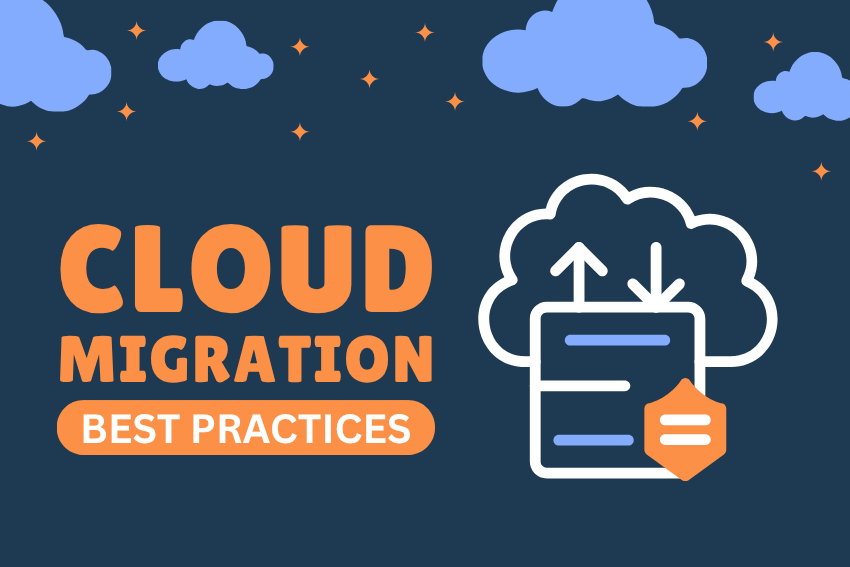Cloud migration plays biggest role in digital transformation for every organization today. Shifting to the cloud means getting greater scalability, flexibility, efficiency, and security while reducing costs.
That said, shifting to the cloud is not as simple as it may seem. Cloud migration comes with its own set of challenges. And to overcome that, organizations must have reliable cloud migration services, a robust governance framework, and best practices. This way, you can ensure your strategy will bring you success in cloud migration.

In this read, we will talk about 10 cloud migration practices you must know to succeed in 2025. But before we dive into the best practices, let’s understand what cloud migration actually is.
What is Cloud Migration?
Cloud migration is the process of transferring all your digital databases from a traditional environment to a cloud environment. A well-strategized and executed cloud migration can drastically improve scalability, decrease costs, increase flexibility, and enhance the performance of the teams.
To pay for what you use, organizations can go for usage-based pricing rather than capital-intensive infrastructure. This way, you scale resources to satisfy your business needs.
The complications involved in this shift depend on the application compatibility, existing architecture, and business goals. To handle these challenges, one must make changes to the application, keeping the cloud migration method in mind.
10 Best Practices for Cloud Migration
Be Clear with Your Business Objectives
Without being clear on what objectives, you want to achieve with cloud migration, you can’t hope for success.
Instead of just looking at the metrics, look at whether your migration strategy is aligning well with your business goals and analyze the chances of migration being successful.
Now, a question arises: How to measure success? To do that, analyze the cost savings targets, performance improvements, and time taken to market.
Evaluate and Prioritize
Begin by evaluating which of your existing IT structures is suitable for the shift and which ones need some changes to make the process easier. Also, identify what benefits you will gain from the cloud migration. For analyzing it, begin with a detailed analysis with respect to your business-specific needs, objectives, and technical requirements.
Note: It’s important to plan your migration in a way that supports your future goals and benefits you in the long run.
After you are done with assessing everything, prioritize the migration of the data based on the complexity, importance, and benefits.
You can first begin with shifting those that have less critical functions to minimize disruptions and keep the highly critical ones for the end.
This way, you will be able to gain time in case any adjustments need to be made before moving on to more essential workloads. Cloud assessment platforms and configuration management databases are some tools that can streamline this phase.
Embrace Automation
Automation has the potential to simplify many phases in the cloud migration process. It can reduce the number of manual errors and speed up the transition. Automation tools like Infrastructure as Code, configuration management, and many more can support application deployment, testing, and ensure smooth performance. If you want to scale, load balance, and enable faster resource automation, it is a must to include in your cloud strategy.
By combining automation with migration, you can standardize processes while making sure there is less human intervention. This approach not only saves time but also helps to allocate resources strategically.
Do a Proper Mapping of Dependencies
Mapping dependencies is important to understand the critical connections between various IT infrastructure details and applications. If you map out these dependencies properly, you will be able to make a group of those applications that share common dependencies. This way, you can migrate them together seamlessly.
Here are some tips to help you create an effective dependency map:
- Don’t start without assessing and interviewing stakeholders to gather information about all the hidden dependencies.
- Use automation tools to capture everything accurately.
- Don’t ignore legacy systems or the complexity of interdependence. Ignoring these common pitfalls can make migration even more complicated.
If mapped properly, you will be able to minimize disruptions while making sure all the important components are taken care of during the planning. It also allows you to move groups according to their importance and dependencies, ensuring better allocation during the migration process.
Use Cloud Cost Optimization Tools and Methods
Proactively manage and optimize cloud costs to ensure migration brings expected financial benefits.
If you can proactively manage and optimize cloud costs, you can bring in expected financial benefits. To ensure you do that, you can use cloud management tools like AWS Cost Explorer, Azure cost management, or Google Cloud Billing. These cloud migration tools will help you keep track of spending patterns and resource usage.
Further, to reduce resource costs specifically, you can use cost optimization technologies that include autoscaling and serverless. There are some 3rd party tools like Densify and CloudHealth that you can use to avoid vendor lock-in.
Lastly, keep a continuous track of tags and budgets, as this will help you manage your investments and make better use of resources.
Test Your Applications
In the cloud migration process, testing is important to ensure that all your applications work as required in the cloud environment. To ensure applications are performing as expected, go for functional testing. As for checking the performance of the application, do performance testing.
Scalability testing will be best for evaluating whether the application can scale as per the changing cloud environment. Additionally, to ensure data protection, you can do security testing.
Ensure Strict Security Measures
The security challenges and standards change when you shift to the cloud. You will get introduced to a new set of security considerations, decided based on network limitations, accountability, and identity management.
When creating a cloud migration strategy, make sure it’s created on the pillars of encryption, authentication, authorization, security, and compliance. This way, you will be able to prevent any possible security threats or breaches.
To make sure your security is never lacking, you can use automation to do continuous security monitoring. Also, add security validation into your CI/CD pipelines and incorporate architectural standards without any disruptions to developer autonomy.
By doing so, you can create security patterns that can be easily adopted by development teams, ensuring consistency across cross-functional teams.
Choose the Right Cloud Providers
Migrating with experts can make sure your efforts are not going to waste, and it will give you results. Cloud migration needs some level of effort, and if you start from scratch, you have to reinvent the wheel.
To avoid that, partnering with reliable cloud service providers is an ideal choice. You can use the full potential of robust infrastructure and services like AWS, Azure, or Google Cloud provided by the cloud providers.
Here are the common questions you need to ask yourself before choosing the right cloud service provider:
- Do their services satisfy your business-specific needs and goals?
- Do they provide compatibility, reliability, and choices in services?
- Do they have a successful track record of providing quality services?
- Do their pricing plans match your migration budget?
Key Metrics for a Successful Migration
Monitoring key metrics on a regular basis will not just ensure that the strategy you are following is on the right track but will also increase the chances of getting expected results. Here are some metrics to keep track of for a successful cloud migration:
- Technical
- Financial
- Operational
- Business
Tracking all of these metrics will give you a proper idea of the errors, frequency of deployment, ROI, resource utilization, cost per transaction, automation coverage, user satisfaction, speed of delivery, and much more.
Use AI and ML for Streamlining Workflows
This doesn’t come as any surprise that AI and machine learning are the most important parts of digital transformation, making the lives of IT teams way easier. Due to its potential to streamline the digital transformation process, it has stood the test of time.
Having AI and machine learning in your migration strategy means having a smart assistant that can handle repetitive tasks while you focus on managing edgy cases, increasing the productivity of the team.
Also, if you leverage the benefits of intelligent analysis, you can identify potential issues early to prevent disruptions and increase the success rates.
With machine learning algorithms, you can automate resource management, make changes in your application anytime you want, and optimize cost-efficiency to meet the budget. With AI and machine learning, you can accelerate migration efforts and make sure performance continues to improve with time.
Want to enhance your migration plan? Want to ensure continuous performance improvement? AI and machine learning are the solution to all.
In a Nutshell
The journey to cloud migration is not an easy path; it needs a lot of effort and a well-thought-out plan to become successful. So, if you want to reap all the benefits that cloud has to offer, you need to build a good, data-driven strategy following the principles below:
- Detailed assessment and prioritization of workloads.
- Proper, well-informed planning.
- Right selection of a cloud service provider.
- Meeting the cloud’s security standards.
- Deploying dynamic data migration strategies.
Following these principles is vital for ensuring a successful cloud migration journey. And the efforts don’t just stop there; they go beyond successful migration. You need to keep a check on potential issues that can occur anytime in the phase by doing testing thoroughly. Monitoring the changes in the cloud environment is important for long-term business success and maximizing the value you can derive from the cloud.
The cloud journey is not about the destination; it’s about the results you drive from the transformation. Working with the right tools, technologies, and cloud partners is key to ensuring you get full benefit from the cloud’s scalability, flexibility, availability, and affordability.
FAQs
What are the phases of cloud migration?
The three important phases are:
- Evaluation and strategizing: You need to evaluate the existing infrastructure and applications thoroughly while creating outlines of the cloud migration strategy.
- Cloud migration: The main process where all the databases and applications are moved from a traditional setting to a cloud environment.
- Continuous optimization: Here, you have to continue optimizing your strategy even after a successful cloud migration to maximize efficiency and value.
How long does cloud migration take?
It depends on factors such as the complexity of applications, the amount of data that needs to be transferred, and the plan that you are following. It usually takes from a few weeks to several months or even longer for migration at a large scale.
How can I ensure a successful cloud migration?
For achieving success in cloud migration, you need to have a proper plan, clear objectives, stakeholder alignment, transparent communication, and continuous optimization. Also, following cloud migration best practices ensures you get all the benefits of the cloud environment.
What are the security challenges of migration?
There are many security challenges, but some key security risks include misconfigurations, data breaches, access control issues, and compliance risks.
Which strategy works the best for businesses?
Every company has a different set of factors on which its success depends. Some of the common factors are business goals, security standards, and existing infrastructure. Also, some of the common strategies that organizations can follow are re-architecting, re-structuring, and hybrid model deployments.
How to choose a cloud service provider?
To choose the right cloud migration service provider, make sure to evaluate experience, client feedback, reliability, security, pricing, and how well their services align with your business requirements and goals.


